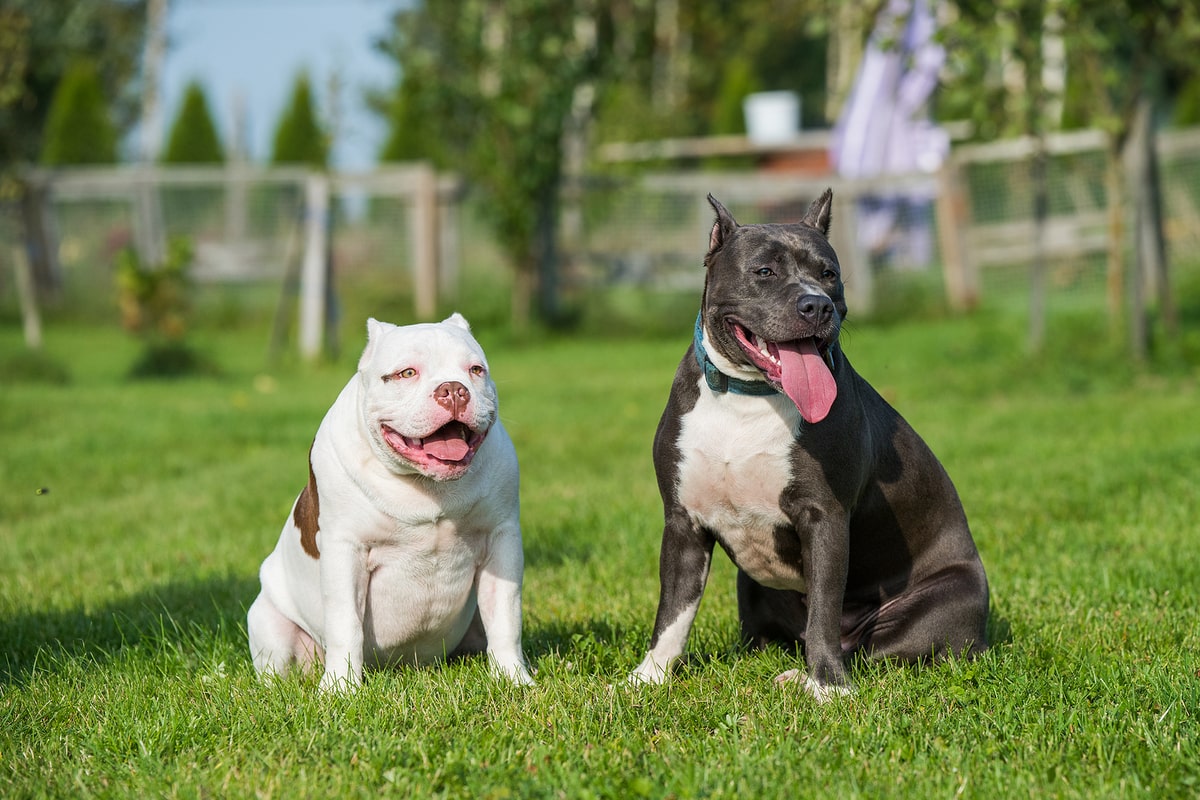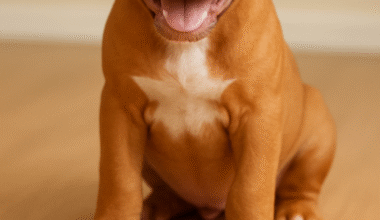“How large is a Pitbull?” is a question many dog lovers ask, especially when they bring home that adorable, pint-sized pup. It’s easy to wonder: will they stay this cute forever, or are they going to grow into a muscular powerhouse? The answer might surprise you! Pitbulls go through various growth spurts, and their size can vary based on factors like genetics, diet, and exercise.
Whether you’re curious about their puppy months or want to know just how big they can get at full maturity, this guide has you covered. Stick around, and by the end, you’ll clearly understand what to expect at every stage of your Pitbull’s growth journey.
Exploring the Different Types of Pit Bulls and Their Care

When considering a Pit Bull as a family pet, it’s essential to understand the various types of Pit Bulls and their unique characteristics. Originally bred in the 19th century for dog fighting, these dogs have evolved into beloved family companions.
With several breeds falling under the umbrella of “Pit Bull,” including American Pit Bull Terriers, Staffordshire Bull Terriers, and American Bulldogs, each breed brings its own traits to the table.
Pitbull Growth Timeline: From Puppy to Adult
A Pitbull’s growth is a dynamic process that spans about two years. During their first year, Pitbulls grow rapidly, especially in the first six months. After this initial growth spurt, their size may plateau, but subtle muscle development and weight gain continue into their second year.
The growth of a pit bull breed is a dynamic process that spans approximately two years. During this time, they transition from playful puppies to fully developed adults, showcasing their strong, muscular build.
- 0-3 Months: At this age, Pitbull puppies are small and typically weigh between 5 to 15 pounds, standing about 6 to 8 inches tall
- 3-6 Months: Expect significant growth in height and muscle mass. They’ll start showing signs of their strong, muscular build. Pitbull often weighs between 30 to 50 pounds and stand about 15 to 18 inches tall. This period is marked by bursts of energy and curiosity as they explore their surroundings.
- 6-12 Months: This is where their growth slows, but they continue to gain weight and muscle.
- 1-2 Years: Most Pitbulls will reach their full height by 12 to 18 months but may continue to gain muscle until they are 2 years old. Example, the Adult American Pit Bull Terriers typically weigh between 30 to 60 pounds and stand 17 to 21 inches tall at the shoulder.
How Large is a Pitbull at 8 Weeks?
At 8 weeks old, Pitbull puppies are usually ready to leave their mother and join their new family. At this stage, they typically weigh between 5 to 15 pounds and stand about 6 to 8 inches tall. Don’t let their small size fool you—these little pups will grow fast.
You can expect them to double or even triple their weight in just a few short months! Their playful and energetic nature will shine through, but they’re still delicate and in need of gentle care at this point. Responsible ownership and training can steer them away from negative behaviors often associated with their history, such as dogfighting.
Pitbull Growth at 6 Months: The Adolescent Stage
By the time your Pitbull hits the 6-month mark, they’ll have gone through several growth spurts. At this stage, Pitbulls typically weigh between 30 to 50 pounds, depending on genetics and gender. They’ll be about 15 to 18 inches tall and start to look like miniature versions of their adult selves.
This is also when they enter their adolescent phase, marked by bursts of energy, curiosity, and sometimes stubbornness. Make sure you’re feeding them a high-quality diet, as proper nutrition during this stage is critical to supporting their growth and developing strong muscles.
Full-Grown Pitbull: When Do They Reach Their Final Size?
So, how large is a Pitbull when they’re fully grown? Pitbulls typically reach their full adult height between 12 to 18 months, but they may continue to gain weight and muscle until they’re about 2 years old. Adult Pitbulls usually weigh between 30 to 60 pounds and stand 17 to 21 inches tall at the shoulder, though this can vary depending on the specific breed.
For example, an American Pitbull Terrier may grow taller and heavier than a Staffordshire Bull Terrier, which tends to be stockier and shorter. It’s important to remember that each dog is unique, your Pitbull’s final size will depend on their genetics, diet, and level of physical activity.
Factors That Affect Pitbull Growth
Not every Pitbull will follow the same growth pattern. Genetics, diet, and lifestyle all play a key role in determining how large your Pitbull will get. Let’s break down the most important factors:

1. Genetics
Just like humans, your dog’s (pitbull) genes are the most significant factor in determining their final size. If your Pitbull’s parents were large, there’s a good chance your pup will grow to be on the bigger side too. Conversely, smaller parents typically produce smaller offspring.
Different Pitbull breeds also vary in size. For example, the American Pitbull Terrier is usually larger than the Staffordshire Bull Terrier, which tends to have a more compact frame. Mixed-breed Pitbulls can inherit traits from other breeds, making it harder to predict their size.
2. Diet and Nutrition
What your Pitbull eats has a direct impact on their growth and development. High-quality dog food rich in protein, healthy fats, and essential vitamins and minerals is critical, especially during the puppy stage when their bodies are developing rapidly.
Malnutrition or feeding low-quality dog food can result in stunted growth, while overfeeding can lead to obesity, putting unnecessary stress on their joints and organs. Puppies need more calories to fuel their growth, but as they transition into adulthood, their diet should adjust to prevent excessive weight gain.
3. Exercise and Physical Activity
Pit bulls are known for their energy and athleticism. They require regular exercise to maintain a healthy weight and develop muscle mass. A Pitbull that’s regularly exercised will have a leaner, more muscular build, while one that is inactive may gain fat instead of muscle.
Physical activity helps burn off excess calories and strengthens their growing muscles, which is particularly important during the puppy and adolescent stages. Aim for activities that engage both their body and mind, such as long walks, runs, fetch, or agility training.
4. Health and Medical Care
Illness or underlying medical conditions can sometimes impact growth. For instance, digestive issues or problems absorbing nutrients can slow down growth or prevent your dog from developing properly. As a pet parent, it’s crucial to be aware of potential health issues, including hip dysplasia, which can affect their mobility
Routine check-ups with a veterinarian can help monitor growth and identify any potential health issues and maintain a healthy weight. Conditions affecting digestion or nutrient absorption can impact overall development.
Additionally, some mixed-breed Pit Bulls may inherit various health conditions from their parent breeds, so understanding their lineage can be beneficial.
Is My Pitbull Growing Normally?
It’s essential to monitor your Pitbull’s growth to ensure they are on track. They should gain weight steadily; if you notice any unusual patterns—either too rapid or too slow—consult your vet.
Every dog grows at their own pace, but it’s natural to wonder if your Pitbull is on the right track. Generally, a Pitbull should be steadily gaining weight and muscle. If you notice your dog isn’t growing as expected, or they seem to be growing too fast, it’s important to consult your vet.
Rapid weight gain can lead to joint problems, while slow growth may indicate underlying health issues. Pay attention to the milestones mentioned earlier—if your dog is significantly underweight or overweight compared to these averages, a check-up with the vet can help rule out any concerns.
How to Support Healthy Growth in Your Pitbull

To ensure your Pitbull grows into a strong and healthy adult, follow these tips:
- Feed a balanced diet: Make sure your Pitbull is eating high-quality food that supports muscle growth and provides essential nutrients.
- Regular exercise: Engage your Pitbull in daily activities like walks, playtime, or agility training to build muscle and prevent obesity.
- Veterinary check-ups: Regular veterinary visits will help monitor your Pitbull’s growth and catch any potential health issues early on.
By providing your Pitbull with the proper care, you’ll help them reach their full size and stay healthy for years to come.
Conclusion
From their tiny puppy days to their strong adult years, Pit bulls undergo remarkable growth. Now that you know the answer to how large is a Pitbull, you can better prepare for each stage of their life. Remember, every dog is unique, and their size will depend on factors like genetics, diet, and exercise.
As long as you’re providing the right care, your Pitbull will grow into a happy, healthy companion. Now that you understand the growth expectations of your Pitbull, you can enjoy watching them grow into the strong, loving dog they’re meant to be!






108 comments
покупка аккаунтов маркетплейс аккаунтов соцсетей
биржа аккаунтов магазин аккаунтов социальных сетей
магазин аккаунтов покупка аккаунтов
маркетплейс аккаунтов https://ploshadka-prodazha-akkauntov.ru/
площадка для продажи аккаунтов маркетплейс аккаунтов соцсетей
гарантия при продаже аккаунтов платформа для покупки аккаунтов
маркетплейс аккаунтов безопасная сделка аккаунтов
Accounts for Sale Account Sale
Accounts for Sale accountsmarketplacepro.com
Account Purchase Accounts market
Accounts marketplace Secure Account Sales
Account marketplace Account Selling Service
Verified Accounts for Sale Account Buying Service
Account marketplace Marketplace for Ready-Made Accounts
Buy Pre-made Account Account Trading
Buy accounts Account Store
Sell accounts Sell Pre-made Account
account marketplace purchase ready-made accounts
account exchange service buy and sell accounts
secure account sales buy pre-made account
account buying platform account sale
account buying service account sale
ready-made accounts for sale website for buying accounts
account exchange service buy account
accounts for sale account store
account market accounts marketplace
account trading platform account market
account selling service accounts for sale
profitable account sales accounts market
account catalog account trading platform
sell accounts account buying platform
account buying service account marketplace
account exchange service buy-social-accounts.org
purchase ready-made accounts https://social-accounts-marketplace.org
account trading service account trading service
gaming account marketplace accounts marketplace
profitable account sales account selling service
Всегда есть что-то интересное из актуального порно онлайн:
Детская порнография
account acquisition secure account purchasing platform
sell pre-made account account purchase
accounts for sale buy account
account trading platform purchase ready-made accounts
accounts for sale account buying platform
website for selling accounts account store
secure account sales marketplace for ready-made accounts
online account store accounts marketplace
account purchase account market
Всегда есть что-то интересное из актуального порно онлайн:
8 летние девушки порно
account market https://social-accounts-marketplaces.live
account selling service https://accounts-marketplace.live/
social media account marketplace https://social-accounts-marketplace.xyz
buy account https://buy-accounts-shop.pro
account trading service https://buy-accounts.live
account catalog https://accounts-marketplace.online
social media account marketplace buy accounts
Could the Ancient African Dog Breed Akua Konama Attakora Be the Missing Link in the Evolution of Modern Pit Bulls? Exploring Possible Genetic Connections and Their Impact on Breed Characteristics. [url=https://www.bizmaker.org/vilnius/business-services/esim-plus-279909]My blog[/url]
buy accounts https://accounts-marketplace-best.pro/
площадка для продажи аккаунтов https://akkaunty-na-prodazhu.pro/
продажа аккаунтов магазины аккаунтов
маркетплейс аккаунтов соцсетей купить аккаунт
маркетплейс аккаунтов купить аккаунт
маркетплейс аккаунтов kupit-akkaunty-market.xyz
продажа аккаунтов https://akkaunty-optom.live/
продать аккаунт https://online-akkaunty-magazin.xyz
маркетплейс аккаунтов akkaunty-dlya-prodazhi.pro
Всегда есть что-то интересное из актуального порно онлайн:
17 летние девушки порно
продажа аккаунтов https://kupit-akkaunt.online
buy accounts facebook https://buy-adsaccounts.work
facebook ad account buy buying facebook account
buy aged facebook ads accounts https://buy-ad-account.top
buy account facebook ads facebook ads accounts
cheap facebook accounts ad-account-buy.top
facebook ads account for sale buy fb ad account
buying facebook accounts buy fb account
buy facebook advertising https://buy-ad-account.click
buy facebook profiles https://ad-accounts-for-sale.work
buy account google ads https://buy-ads-account.top
buy account google ads https://buy-ads-accounts.click
buy facebook advertising accounts https://buy-accounts.click
google ads accounts https://ads-account-for-sale.top
buy google adwords account https://ads-account-buy.work
buy google adwords account https://buy-ads-invoice-account.top/
buy google ad account https://buy-account-ads.work
google ads agency accounts buy google ads account
buy google ads verified account https://sell-ads-account.click
buy google ads threshold account google ads accounts
buy business manager https://buy-business-manager.org
google ads agency accounts https://buy-verified-ads-account.work
facebook business manager for sale https://buy-bm-account.org
facebook business manager for sale https://buy-verified-business-manager-account.org
buy verified facebook business manager https://buy-verified-business-manager.org/
facebook bm buy https://buy-business-manager-acc.org
buy verified facebook business manager business-manager-for-sale.org
facebook verified business manager for sale buy-business-manager-verified.org
buy facebook business account buy business manager
buy facebook bm facebook bm for sale
tiktok ads account buy https://buy-tiktok-ads-account.org
facebook business manager account buy verified-business-manager-for-sale.org
tiktok ads account buy https://tiktok-ads-account-buy.org
tiktok agency account for sale https://tiktok-ads-account-for-sale.org
buy tiktok ads accounts https://tiktok-agency-account-for-sale.org
tiktok ads account for sale https://buy-tiktok-ad-account.org
buy tiktok ad account https://buy-tiktok-ads-accounts.org
tiktok agency account for sale https://tiktok-ads-agency-account.org
tiktok agency account for sale https://buy-tiktok-business-account.org
tiktok ad accounts tiktok ads agency account
наиболее увлекательное эго смотрю тут [url=https://prizyv.ru/]детское порно[/url] сугубо увлекательное я смотрю шелковичное дерево [url=https://niyamatver.ru/shop/] молодые девочки[/url]
наиболее интересное ты отношусь тут [url=https://vkucnee.ru/ru-ru/]детское порно[/url] наиболее увлекательное эго глазу тут [url=https://niyamatver.ru/shop/] молодые девочки[/url]